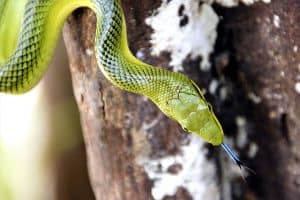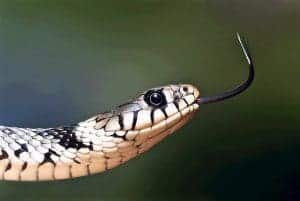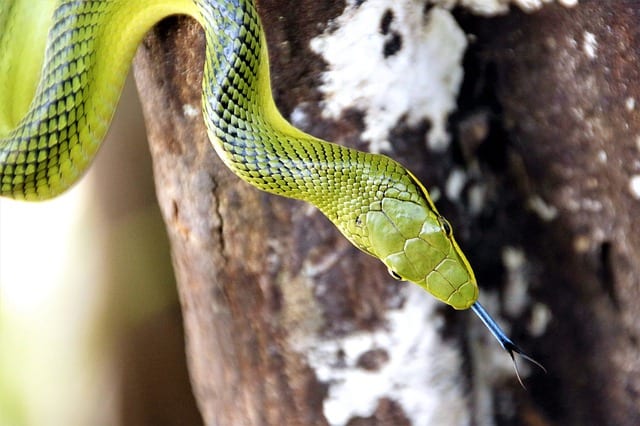 Sometimes it’s the really seemingly basic questions that keep you up at night. While we’ve done plenty of really specific articles on important topics like telling copperheads apart from mimics, properly ID’ing water moccasins, or spending over 100 hours compiling the most complete list of venomous U.S. snakes found anywhere online, sometimes it’s the basic questions that actually really grab the attention.
Sometimes it’s the really seemingly basic questions that keep you up at night. While we’ve done plenty of really specific articles on important topics like telling copperheads apart from mimics, properly ID’ing water moccasins, or spending over 100 hours compiling the most complete list of venomous U.S. snakes found anywhere online, sometimes it’s the basic questions that actually really grab the attention.
Just why are snakes’ tongues forked? What’s the advantage to that and do all snakes have forked tongues?
Yes, these are actually the types of odd questions I think about at night, and based on the number of high-level websites that have talked about this, I’m not the only one. In fact, I’ve found in-depth science journal articles about just this topic!
So why do snakes have forked tongues? The short of it is that snakes use their tongue in combination with a special organ connected to their brains called “Jacobson’s Organ” in order to smell. The forked tongue allows snakes to accurately use “three-dimensional” smell covering a larger area to spot predators, prey, and other objects or animals of interest in an area.
Snakes aren’t the only animals to have forked or bifurcated tongues, although they are the ones most associated with this trait. While a lot still isn’t known about the evolution of snakes or why their tongues are split, what we do know is pretty dang fascinating.
 Why Do Snakes Stick Their Tongues Out?
Why Do Snakes Stick Their Tongues Out?
This goes hand in hand with the question of “Why do snakes have forked tongues?” The Science Explorer does a great job of summarizing the scientific side of answering this question. The tongue is the main way that a snake gets information about the environment around them. While this is done through smell, they get way more out of that information than we do.
Snakes smell with their tongue by “tasting” the air, and the molecules of scents that are there. This gives them the ability to smell potential prey to eat, potential predators to avoid, or other snakes to mate with. Snakes have a “vomeronasal organ” which is referred to as Jacobson’s Organ, which connects the smells from the tongue to the brain.
Think of the tongue almost like an antenna, and each prong putting out an invisible cone of information in that direction. By having the forked tongue a snake gets so much more in-depth information about the environment around them. This combination of different directions and having the forked tongue means that they get a full three dimensional sense of their surroundings, which is incredibly useful whether avoiding danger, hunting for food, or looking for a potential mate.
As an interesting side note, some studies on rattlesnakes have shown that many venomous snakes specifically know how to track their own venom. For “strike and release” predators like rattlesnakes this acts like “prey GPS” to help them find the prey they envenomed earlier in the day. This article goes into more about that.
Pretty crazy, huh? Not only 3-D smell, but prey GPS as well!
So why do snakes stick their tongues out?
- To find food (prey)
- To look for potential predators or dangers
- To get a full sense of their surroundings
- To find a potential mate
Where Do Snake’s Tongues Go When They Bite?
Odd question – sure. But look at the many pictures online of snake looking to bite or strike. This is especially true with pictures of a venomous snake in the middle of the strike. Notice something interesting?
In all these pictures there is no sign of a forked tongue whatsoever.
This makes sense since the tongue is so important to a snake being able to survive and thrive that it can’t be out there when the snake is fighting. There would be too high of a chance of damaging the tongue.
So for anyone who wanted to know where a snake’s forked tongue goes when it gets in a fighting mood, it is protected
There is a fantastic detailed drawing of where everything is, including the snake’s tongue sheath and how it works, found at Merriam-Webster’s online visual dictionary. Follow the link to see it in detail.
Many Reptiles Have Forked Tongues
Snakes aren’t the only ones with forked tongues. In fact, many lizards use the same advantage in the wild. Lizards of all types have forked tongues which serve the same purpose: allowing them to taste the air and get a sense for potential predators, prey, and mates. In fact, reptiles with forked tongues are known as squamate reptiles and they use their tongues to taste all the chemicals in the air which tells them all they need to know.
From small lizards to large iguanas or even the giant komodo dragons, the forked tongue is something you consistently see from snakes and lizards. Considering how many there are throughout the world, it shows just how amazing this evolutionary choice is.
Forked Tongue Symbolism in Culture
Unfortunately for snakes, they have received a pretty bad rap in mythology and culture stretching from the legless movement to the unblinking eyes to the forked tongue itself. In Western culture “forked tongue” often comes from Judaism and Christianity symbolism and it usually means being deceptive, hypocritical, or something along those lines.
That’s why the line “Speaking with a forked tongue” refers to someone who says one thing but then clearly acts in a different or deceptive way.
This even goes beyond stories of the talking snake. Pictures from medieval times or even more recently show many depictions of the Devil, often with a forked tongue coming out of his mouth.
This might not be flattering in pop culture at any point, but it shows how clearly distinctive this trait is.
Snake Tongue FAQ
Q: Why are snake’s tongues split?
A: The split at the end of the tongue allows snakes to get much more information from a much larger area. When all this information is combined together it allows for a three-dimensional picture of the area around them. If the tongue wasn’t split, they wouldn’t have nearly so much information or be able to pinpoint things with the accuracy they can with the current setup.
Q: Why do snakes stick their tongues out?
A: The only way for snakes to use their amazing sense of smell is by flicking the tongue out. This could be because they’re hungry and looking for food. It could be because they’re looking for predators to see how safe an area is and locate any potential danger. This could be because it’s mating season – or it could be just to get general information. Unlike people with five main senses to work with, virtually everything in the snake’s system is designed to rotate around that sense of smell, meaning the tongue needs to flick out to activate their ability to smell the environment around them.
Q: What is a snake looking for when it sticks its tongue out?
A: Depends on the mood and situation. Snakes will frequently flick the tongue out just to check the environment for safety’s sake. Even venomous snakes are well aware of how many animals are much, much bigger than they are. Because they get all their data about an area from their next level sense of smell, they need to flick the tongue out to gather information of any kind.
Q: What is a Jacobson’s Organ?
A: This is the specific little vomeronasal organ that connects the sense of smell from the tongue to the actual brain. This is what allows the snake to smell through their tongue and what gives them such an incredible amount of information as a result.
Q: Can snakes really “smell” in 3-D?
A: Yes. Because of the specific design of the split of the tongue this acts like getting information from two different locations that can then “triangulate” the information to create a 3-D image of the area around them.
Q: What other animals have forked tongues like snakes do?
A: Very few although many lizards also have forked tongues and while not exactly the same (or serving the same function) some other animals like hummingbirds even have a slightly different tongue that creates an almost split tongue type of look.
Q: Do snakes really smell with their tongues?
A: They do, but that’s also a very understated way of putting it. The amount of information that a snake gets about their surrounding environment through smelling with their tongue is way above and beyond what even the most sharp-nosed human is capable of pulling off.
Q: What does it mean when snakes stick their tongues out?
A: This doesn’t specifically mean anything. Although there are some theories that with certain species you can study the frequency or number of flicks to get an idea of what they’re focusing in on, this has not been proven as of yet in laboratory testing.
Q: Do humans have vomeronasal organs?
A: Yes, technically humans do, but they are vestigial organs in humans meaning they’ve faded away over time to not be useful or used as other evolutionary changes proved superior. So in people these are just like the appendix – they’re leftovers that are no longer used.
Q: Why don’t snakes use their other senses more?
A: The forked tongue is one of the best survival features a snake has due to evolution. They can see, but their eyes don’t move. That means the entire body needs to move to see things and there would be obvious blind spots. Snakes have a vibration-sensitive bone that works sort of like an ear even though technically they don’t hear. So that sense of smell better be amazing, and the 3-d model of the world all around them that is only possible because of two tongue points gives them that potential advantage.
In Conclusion
There you have it! Snakes definitely have very unique looking tongues and it turn out there are really good evolutionary reasons for that. Whatever your thoughts on snakes in general, there’s little question that they are a fascinating animal that plays a very important part in most ecosystems.
And now you know all you need to know about snakes and their forked tongues.

